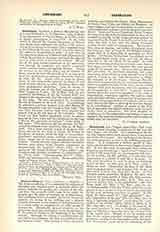

Genesius, (I) a comedian at Rome, martyred under Diocletian in 286 or 303. Feast, August 25. He is invoked against epilepsy, and is honored as patron of theatrical performers and of musicians. The legend (Acta SS., August, V, 119) relates: Genesius, the leader of a theatrical troupe in Rome, performing one day before the Emperor Diocletian, and wishing to expose Christian rites to the ridicule of his audience, pretended to receive the Sacrament of Baptism. When the water had been poured upon him he proclaimed himself a Christian. Diocletian at first enjoyed the realistic play, but, finding Genesius to be in earnest, ordered him to be tortured and then beheaded. He was buried on the Via Tiburtina. His relics are said to be partly in San Giovanni della Pigna, partly in S. Susanna di Termini and in the chapel of St. Lawrence. The legend was dramatized in the fifteenth century; embodied in later years in the oratorio “Polus Atella” of Lowe (d. 1869), and still more recently in a work by Weingartner (Berlin, 1892). The historic value of the Acts, dating from the seventh century, is very doubtful, though defended by Tillemont (Memoires, IV, s.v. Genesius). The very existence of Genesius is called into question, and he is held to be a Roman counterpart of St. Gelasius (or Gelasinus) of Hierapolis (d. 297). He was venerated, however, at Rome in the fourth century; a church was built in his honor very early, and was repaired and beautified by Gregory III in 741.
GENESIUS of ARLES, a notary martyred under Maximianus in 303 or 308. Feast, August 25 He is honored as patron of notaries, and invoked against chilblains and scurf. The Acts (Acta SS., August, V, 123, and Ruinart, 559), attributed to St. Paulinus of Nola, state: Genesius, native of Arles, at first a soldier, became known for his proficiency in writing, and was made secretary to the magistrate of Arles. While performing the duties of his office the decree of persecution against the Christians was read in his presence. Outraged in his ideas of justice, the young catechumen cast his tablets at the feet of the magistrate and fled. He was captured and executed, and thus received baptism in his own blood. His veneration must be very old, as his name is found in the ancient martyrology ascribed to St. Jerome. A church and altar dedicated to him at Arles were known in the fourth century.
GENESIUS, twenty-first Bishop of Clermont, d. 662. Feast, June 3. The legend, which is of a rather late date (Acta SS., June, I, 315), says that he was descended from a senatorial family of Auvergne. Having received a liberal education he renounced his worldly prospects for the service of the Church, became archdeacon of Clermont under Bishop Proculus, and succeeded him in the episcopacy in 656. He labored earnestly for the maintenance of Christian morality, and founded a hospital at Clermont and also the Abbey of Manlieu. After five years, fearing for his own soul, he left Clermont secretly and went to Rome in the garb of a pilgrim. The bereaved flock sent a deputation to the Holy See. Genesius was found and induced to return. He then built a convent at Chantoin. He was buried in the church which he had built at Clermont in honor of St. Symphorian, and which later took his own name. In the life of St. Prix (Praejectus), Genesius is mentioned as one of the protectors of his childhood.
GENESIUS, Count of Clermont, d. 725. Feast, June 5. According to the lessons of the Breviary of the Chapter of Camaleria (Acta SS., June, I, 497), he was of noble birth; his father’s name is Oven as Audastrius, and his mother’s as Tranquilla. Even in his youth he is said to have wrought miracles—to have given sight to the blind and cured the lame. He built and richly endowed several churches and religious houses. He was a friend of St. Bonitus, Bishop of Clermont, and of St. Meneleus, Abbot of Menat. He was buried at Combronde by St. Savinian, successor of Meneleus.
GENESIUS (or GENESTUS), thirty-seventh Archbishop of Lyons, d. 679. Feast, November 1. He was a native of France, not of Arabia or Armenia as is sometimes stated, and became a religious and abbot (not of Fontenelle, but) attached to the court and camp of Clovis II, where he acted as chief almoner to the queen, St. Bathildis. He succeeded St. Chamond (Annemundus) in the See of Lyons, and was consecrated in 657 or 658. His name is found for the first time as bishop in a signature of September 6, 664, attached to a charter drawn up by Bertefred, Bishop of Amiens, for the Abbey of Corbie. On June 26, 667, he subscribed another charter framed by Drauscius, Bishop of Soissons, for a convent of the Blessed Virgin founded by Ebroin, mayor of the palace, and his wife Leutrude. In the conflict between Ebroin and St. Leger (Leodegarius), Bishop of Autun, Genesius (675-76) took the part of the bishop and was in consequence attacked by an armed band sent by Ebroin to expel him from Lyons; but Genesius collected a force and successfully defended his city. In September, 677, he assisted at an assembly held at Maslay. He was succeeded at Lyons by Landebertus. His body remained in the church of St. Nicetius till the beginning of the fourteenth century, when it was transferred to Chelles.
FRANCIS MERSHMAN

